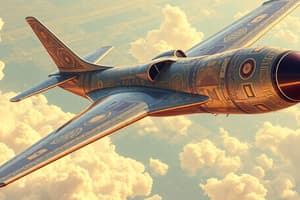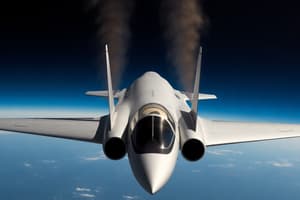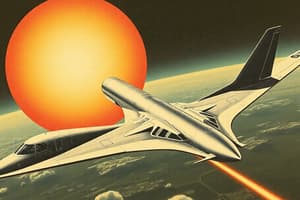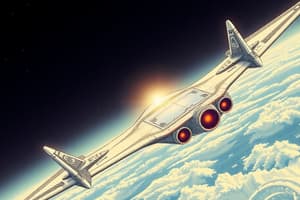Podcast
Questions and Answers
What is the primary goal of NASA's X-59 project?
What is the primary goal of NASA's X-59 project?
- To enable supersonic flight over land without creating disruptive sonic booms. (correct)
- To develop a new type of rocket fuel.
- To design an aircraft capable of evading radar detection.
- To test the effects of high-altitude flight on the human body.
What was a major factor that contributed to the limited success of the Concorde?
What was a major factor that contributed to the limited success of the Concorde?
- The lack of passenger demand for supersonic travel.
- Its inefficient fuel consumption.
- Its inability to fly at supersonic speeds.
- The loud sonic boom it produced, restricting its flight paths. (correct)
Which design feature of the X-59 significantly contributes to reducing the sonic boom?
Which design feature of the X-59 significantly contributes to reducing the sonic boom?
- The placement of the wings at a 45-degree angle.
- The long, pointed nose that disrupts shock waves. (correct)
- The use of lightweight aluminum in its construction.
- The inclusion of large, forward-facing windows in the cockpit.
How does the X-59 compensate for the absence of a forward-facing window in the cockpit?
How does the X-59 compensate for the absence of a forward-facing window in the cockpit?
What is NASA planning to do after the initial safety tests of the X-59 are completed in California?
What is NASA planning to do after the initial safety tests of the X-59 are completed in California?
According to the content, what is the potential timeline for the emergence of new commercial supersonic aircraft if the X-59 project is successful?
According to the content, what is the potential timeline for the emergence of new commercial supersonic aircraft if the X-59 project is successful?
How does the placement of the engine on the X-59 contribute to reducing the noise impact on the ground?
How does the placement of the engine on the X-59 contribute to reducing the noise impact on the ground?
Imagine that the X-59's tests reveal that while the sonic boom is significantly reduced, it is not entirely eliminated. Which of the following actions would be the MOST strategic for NASA to take to still potentially achieve its long-term goals?
Imagine that the X-59's tests reveal that while the sonic boom is significantly reduced, it is not entirely eliminated. Which of the following actions would be the MOST strategic for NASA to take to still potentially achieve its long-term goals?
Flashcards
Supersonic Speed
Supersonic Speed
Speeds faster than the speed of sound, approximately 768 mph (1,236 km/h).
Sonic Boom
Sonic Boom
An intense sound produced when an aircraft exceeds the speed of sound.
QueSST
QueSST
NASA's project aiming to enable supersonic flight without the loud sonic boom.
Concorde
Concorde
Signup and view all the flashcards
X-59's Long, Pointed Nose Design
X-59's Long, Pointed Nose Design
Signup and view all the flashcards
Engine Placement of X-59
Engine Placement of X-59
Signup and view all the flashcards
Purpose of X-59 Flight Tests
Purpose of X-59 Flight Tests
Signup and view all the flashcards
Potential Impact of X-59
Potential Impact of X-59
Signup and view all the flashcards
Study Notes
- NASA's X-59 aircraft, revealed in January 2024, aims to revolutionize travel by achieving supersonic speeds without the loud sonic boom.
- The X-59 is a prototype for NASA's Quiet SuperSonic Technology (QueSST) mission.
- The goal is to make air travel over land twice as fast, safe, sustainable, and quieter than before.
- Supersonic speed is defined as any speed faster than the speed of sound, approximately 768 mph (1,236 km/h).
- Aircraft breaking the sound barrier produce intense sonic booms that can damage buildings.
- The sonic boom issue contributed to the failure of the Concorde, which was restricted to flying at top speeds over the ocean.
- The X-59's design includes a long, pointed nose to disrupt shock waves and minimize noise.
- It lacks a forward-facing cockpit window, using advanced cameras for pilot visibility.
- The engine is positioned on top to direct noise away from the ground.
- NASA plans to test the X-59 in California in late 2024.
- After safety checks, the X-59 will fly over U.S. cities to gather community feedback on its sound.
- NASA aims to use the collected data to encourage the reconsideration of rules against supersonic flights over land.
- If successful, the X-59 could lead to new commercial cargo and passenger supersonic aircraft by 2030.
Studying That Suits You
Use AI to generate personalized quizzes and flashcards to suit your learning preferences.





